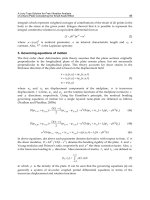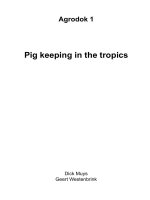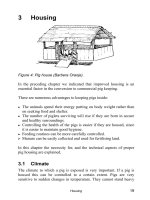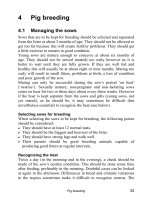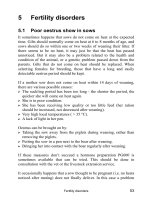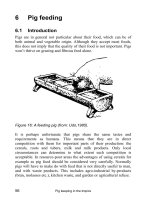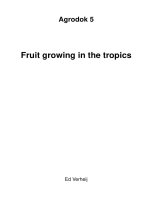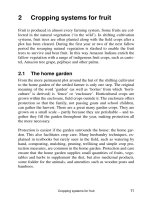Goat keeping in the tropics - Part 4 pdf
Bạn đang xem bản rút gọn của tài liệu. Xem và tải ngay bản đầy đủ của tài liệu tại đây (204.43 KB, 19 trang )
Goat keeping in the tropics
28
4 Nutrition and feeding
Goats are essentially browsers. They can feed themselves off trees and
bushes in places where there is not enough vegetation for sheep and
cattle. Their tongues and flexible top lips make it easy for them to pick
leaves from between the thorns. They will even eat bark and exposed
roots.
Goats can keep themselves in reasonable condition in difficult circum-
stances, because the first part of their stomach system. Their rumen
(see figure 6 on page 30) is full of micro-organisms who help them
convert poor quality fibre into usable nutrients. Their digestive system
is actually an adaptation to drought. Their liking for tree leaves also
means that they have an extra supply of protein, with the result that
they are usually in better condition at the end of the dry season than
sheep or cows who can’t make such good use of tree leaves.
Despite this, if we want our goats to produce good meat quickly, or
lots of kids and milk, we will have to feed them well. They will need
protein in particular, which is not often available in sufficient quantity
in their natural diet.
It is particularly the pregnant and milking nannies that need extra
feeding. In the last month of pregnancy they will need twice as much
energy and protein as normal. Don’t let them start using up their body
reserves, as their kids and future milk production will suffer.
Once nannies start producing milk they will continue to need quality
feed. Without it they will lose weight, using up their body reserves.
This means that their milk production will drop. If this happens you
will probably not be able to get their milk levels up again.
4.1 Supplying the essential requirements
Water
Although goats obtain some water from the natural moisture in their
food, this will rarely be enough. This is especially so during the dry
Nutrition and feeding
29
season when the feed is very dry. Dry grass or straw only contains 10 -
15 % water.
As temperatures rise, goats lose more and more body water, and their
need to drink increases. If goats don’t find enough water, they will eat
less food and their production will drop.
In the wet tropics, on the other hand, feed can actually contain too
much moisture (more than 80 %). This can result in inefficient diges-
tion and the goats will have to eat tremendous amounts to take in suf-
ficient nutrients.
Goats need between 3 and 8 liters of clean water per day. Milking
goats need plenty of water (milk production makes all the animal’s
organs work at peak performance), whilst meat animals will need less.
Water goats once a day and at a regular time, so that they develop a
routine and learn to expect it. The temperature of the water itself is
also important. The cooler it is, the less they will need and the more
they will eat. So keep the water cool and change it frequently so that it
does not heat up. This will also keep the water clean - this is important
as goats will refuse dirty water.
Energy
Goats first and foremost need energy-giving food. They need energy
to keep their body functioning and their temperature normal. They
also need energy to keep active. Besides this, goats needs extra energy
to grow (and therefore produce meat) and to reproduce (feeding the
foetus and then producing milk). See Appendix 1 for details on re-
quirements.
Sources of energy-giving food
Energy is obtained mainly from the carbohydrates in leafy and stalky
feed, in roots, tubers, bananas etc. These are normally available lo-
cally, and they form the bulk of a goat’s ration.
Fat-containing plants supply 2 -3 times as much energy as carbohy-
drate food. There is a lot of fat (and therefore energy) in the seeds of
oil crops like soya, cotton, sunflower, groundnut and coconut. Even
after oil extraction, the “oil cake” that is left over is energy-rich.
Goat keeping in the tropics
30
Sugar is also an important energy food. It can be supplied by feeding
molasses and fruit residues.
Protein
Protein is needed for growth, building up body fat, and for the essen-
tial bodily functions.
Strangely enough, the goat’s minimum protein requirements are pro-
vided by its own digestive system (see below). The system provides
enough to keep the goat alive, but not enough to produce good meat or
lots of kids and milk. For this the goat will need extra protein and it is
important that you provide this. See Appendix 1 for details on re-
quirements.
The goat’s digestive system
To understand why goats have a special need for protein it is neces-
sary to understand how they digest their food. There are two main
stages in the digestive proc-
ess:
1 The high-fibre food or
“roughage” eaten floats as a
thick layer on the fluid in
the goat’s rumen. This fluid
is home to countless micro-
organisms who start break-
ing up the coarse plant ma-
terial. These micro-
organisms themselves live
off the fibrous food that the
goat eats. They need fi-
brous food and nutrients to function well and multiply. They live
and die in the rumen, and their remains become an important source
of protein for the goat.
2 After the food has passed through the rumen, the rest of the diges-
tive system starts to work on what remains to be digested - princi-
Figure 6: The goat’s rumen
Nutrition and feeding
31
pally those nutrients that escaped the rumen process, plus the re-
mains of dead and dying micro-organisms. This is all then absorbed
into the blood, which carries the nutrients to the other parts of the
body.
Sources of protein
The young leaves of vegetables, cabbages, grasses all contain protein.
Shrub and tree leaves have a high protein content all the year round,
especially those of pod-bearing trees (nitrogen-fixing leguminous
trees like Leucaena, Sesbania, Glyricidia, or Pigeon pea).
Legume crops such as soya and groundnuts are very rich in protein
(and fat), and this is true even for the “waste” remaining after oil ex-
traction (soya bean meal, groundnut meal). See also Appendix 1.
The residues left after cereal and cottonseed processing (brewer’s
grains, rice polishings, cottonseed meal) are also rich in protein.
Minerals
Goats cannot live without minerals. Salt, calcium, phosphorus, and
trace elements like iron, copper and iodine are very important. They
not only help to maintain and regulate the bodily functions, but they
also strengthen the teeth and bones. They are also especially important
for young kids, and for pregnant and milking nannies.
A lack of minerals will lead to a poor appetite, a dull coat, poor
growth and reduced fertility. An animal will lick all kinds of objects
and even try to eat them in the search for extra minerals. Remember
that a goat will first draw on its own body reserves to compensate for
any deficiency. This means that you may only begin to notice the
problem long after it has set in. The best way to avoid mineral defi-
ciencies is to supply as varied a diet as possible. In Appendix 3 we
give a recipe of a saltlick that contains also the other minerals and
which you can make with local materials.
It is also true that an excess of minerals can be harmful. Be careful
therefore in your use of commercial or homemade mineral prepara-
tions.
Goat keeping in the tropics
32
? Salt
You can supply salt in the form of a salt
lick, or inside a hanging piece of bamboo
about 10 cm wide with holes in the bot-
tom (see figure 7). It is important to pro-
tect the salt from rain, as it easily dis-
solves and disappears.
Milking goats need more salt, as they
will lose a lot in their milk. Without salt
their appetite goes down and their diges-
tion weakens.
? Calcium and phosphorus
Calcium and phosphorus are important
for the bones. Calcium is usually avail-
able in green leaves, especially those of
the leguminous trees and shrubs. Phosphorus is common in seeds
and cereals. Again, milking goats will need more calcium and phos-
phorus than non-milkers.
? Iron
A lack of iron will bring on anaemia, a blood problem. It can be de-
tected by seeing if the skin and membranes under the eyelids are
pale in colour.
Plants with dark green leaves are often good iron carriers. If a goat
starts eating soil it is probably looking for iron.
? Iodine
Without iodine nannies will give birth to weak, deformed or even
stillborn kids. They may develop a swollen thyroid gland (goitre).
Iodine shortage can be prevented by giving sea salt, or normal salt
with iodine added.
Vitamins
It is difficult to generalise about the vitamin content of feeds, as there
is great variation from plant to plant. Some vitamins can be produced
Figure 7: Bamboo salt
lick with perforated
bottom
Nutrition and feeding
33
by the micro-organisms in the rumen. Normally an adult goat on a var-
ied diet will not need vitamin supplements. If there really is a shortage
that cannot be improved by varying the feed, vitamins and trace ele-
ments can be bought in.
Vitamin A
Generally vitamin A is the only vitamin that may be in short supply. A
lack of vitamin A results in eye disorders, skin ailments (flaking and
growths) and breathing and digestive problems. The birth of frail kids
is also possible. Milking and pregnant goats need more vitamin A than
animals raised for meat.
Vitamin A comes from carotene, a substance found in the green plant
parts and in the yellow or red parts of plants like sweet potatoes and
carrots. The carotene content of feed declines sharply in storage, and
this explains why there is often a shortage during the dry season.
4.2 Feeding practices
Feeding practices actually depend on local conditions, the season, the
types of foodstuff available, the possibilities for growing and storing
fodder, and the resources available for buying in feed. There are three
broad strategies possible:
1. The goats are left free to find their own food
The goats find their own food, they are browsing, grazing, or on a
tether.
If the rangeland is fresh and green they should normally find enough
for their needs by browsing and grazing.
Improvements
The protein quality of the rangeland may have to be improved by in-
troducing more nutritious grasses, or legumes such as Desmodium.
Fodder trees can also be planted where goats graze, leguminous trees
in particular with protein-rich leaves. These can also be planted in
lines to form live fences (See Agrodok 16 on Agroforestry).
Goat keeping in the tropics
34
2. Goats are free-range, extra food is given
The goats can be left to forage free-range for part of the day but are
brought in to be fed the main part of their ration. The browsing sup-
plies some of the goats’ needs, but manual feeding provides the
greater part.
In the dry season free-range goats will only find dry vegetation or crop
residues in the fields. These may supply some energy, but the protein
content is very low. Even by cutting and carrying such foodstuffs to
enclosed animals it will be hard to meet their requirements.
Improvements
If you can afford it, feed the goats fruits and vegetables like cassava or
sweet potatoes, or the leaves of these plants. Banana peelings, and
sugar cane tops are also suitable, although not so nutritious. Feed sup-
plements will also have to be given, as explained later in this chapter.
If goats are enclosed during the rains, fresh grasses, legumes, tree foli-
age should be cut for them. Fodder trees
are useful for this. Crop thinnings or
cuttings (maize, sorghum etc.) can also
be fed, as well as weeds. Sweet potato
vines are very nutritious.
The feed should be provided in racks or
troughs to allow all the animals easy
access without having to fight over the
food.
A rope or net can also be used for feed-
ing. Don’t throw the feed on the ground
if the goats are likely to trample on it, as
it is too precious to spoil.
See also figure 18, Chapter 5.
Figure 8: Feed on rope
(Adapted from: Peacock,
1996)
Nutrition and feeding
35
3. Goats are completely fed manually
The goats can be kept enclosed, and are fed a complete ration in the
enclosure. This means cutting or collecting food and carrying it to the
animals, possibly supplemented with concentrates.
Whatever the system, stocks of hay, silage or straw/urea (see below) may
have to be fed in lean periods of the year, when seasonal supplies run out.
Levels of feeding
The amount of feed a goat needs depends on:
? its size (a big goat needs more than a little one!)
? its level of activity (Is it is having to spend energy foraging into
shrubs, or is it being served its food in a compound or shed?)
? what it is being asked to produce (a milking nanny will need far
more than a meat goat).
You can’t force goats to eat, but in general the more they eat the better.
Their eating habits will depend on their personal preferences, the taste
and smell of the food, and the climatic conditions. If local supplies are
good enough you should try to persuade (or trick!) them into eating
cheaper and more easily available feed.
Combining the feeds
The priority when feeding goats is to keep the digestive system func-
tioning properly. This means looking after the micro-organisms in the
rumen, by feeding them both nutrients and “roughage” (food with a
high fibre content).
Roughage
Roughage is fundamental to the well-being of the goat. Some of it is
rich in nutrients as well as fibre. Fresh plant material, especially
young grass or leafy green fodder, is high quality forage. It can satisfy
all a goat’s needs.
Goat keeping in the tropics
36
Most roughage however is unnutritious fibre of poor quality. This in-
cludes crop residues and dry season grasses. These will have to be
supplemented with more nutritious food or concentrates.
You need to decide on how much and what to feed in the light of what
is available locally. It is difficult to suggest exact proportions, as there
is great variation in the type and quality of foods available, and the
needs of the goats themselves will vary with local conditions. A typi-
cal method for calculating a ration is given in Appendix 1.
Hay and silage
High quality roughage can be supplied in the dry season by feeding
hay or silage. This is greenstuff such as grass (or other plants) that has
been cut early in growth and conserved by drying or fermenting. Hay-
and silage-making are important but labour-demanding techniques.
They are useful in areas where the wet season supplies plenty of grass
but where the lean season can create serious fodder shortages. Hay-
and silage-making procedures are described at the end of this chapter.
Hay
Hay consists of grass cut young and green and dried in the field. Hay
is stacked loose or in bales, and can be saved for months, to be fed in
times of food shortage. It has high nutritional value. “Standing hay”
refers to the dried grass left to stand (uncut) in the fields during the
dry season. It is a useful but poor-quality feed for goats.
Silage
Silage is grass that is cut and then fermented. The nutritional value is
high.
Straw and urea
Straw is widely used as feed. Its nutritional quality can be improved
by increasing its nitrogen content, as nitrogen makes the fibres more
digestible. This is done by treating the straw with urea. The smell of
ammonia from the urea may be unpleasant but it is not harmful to the
animals. There is more information on urea in the following section.
Nutrition and feeding
37
Goats fed with treated straw will still need extra protein and mineral
supplements. These are covered in a later section.
? A stack of straw should be treated with urea several weeks before feeding.
The straw is stacked in layers, and, as each layer is laid, a mix of water
and urea is poured onto each layer. Use a watering can for more even dis-
tribution.
? Every litre of water should contain 40 gram of urea.
? For every kilo of straw 0.8 liters of the water/urea m ix should be poured.
Make an estimation of the average weight of each layer of straw by weigh-
ing it, and then work out how many liters of water you should pour on every
layer.
? Once built, the stack should be covered and sealed with a plastic sheet.
? Leave it for about three weeks, then open the stack. Leave it to ventilate,
so the smell of ammonia can fade before feeding it.
4.3 Feed supplements
In the dry season, and whenever good levels of production are being
aimed for, goats will probably need extra protein, energy, vitamins and
minerals. There are various possibilities available for providing these.
Leguminous trees or shrubs
When the dry season sets in, trees and shrubs can provide forage long
after the grass has dried. Trees in general and leguminous trees in par-
ticular (planted especially for this reason) can function as excellent
‘fodder banks’. The leaves can be cut and carried to the goats, or goats
can be left to browse among the trees for a while. Browsing is not al-
ways advisable however because the trees may be damaged.
If goats are left to forage free-range for most of the day but are
brought back to be fed or browse leguminous tree leaves, it is impor-
tant to make sure that they are not overfed on dried grasses or crop
residues. So that they keep their appetite for the green nutritious
leaves.
Examples of leguminous trees: Leucaena, Proposis, Sesbania.
Goat keeping in the tropics
38
Industrial by-products
These consist of the residues left over at the end of food processing.
They include molasses, brewers’ grains, rice-bran, wheat bran, cotton-
seed meal, linseed cake, groundnut cake, coconut cake, etc They can
be important protein- and energy-rich foods in their own right.
Although they may be difficult to obtain, it is worth the effort, as these
feeds are often very nutritious. A small amount of these combined
with locally available feed of moderate quality can greatly improve
the quality and digestibility of the ration as a whole.
Individual animals will fight over quality feed. To ensure that all the
goats get their share, the best method for feeding cakes or powders is
to pellet them and trail the pellets over long distances. Otherwise they
could be reserved for feeding individually to pregnant and suckling
animals.
Concentrates
Concentrates are food supplements fed to supply extra energy or pro-
tein. They include some of the industrial by-products mentioned
above, and other products such as fish meal. They must be fed with
some roughage. If concentrates are fed with too little roughage the
rumen will not function well.
Concentrate foods are often part of a farming household’s diet. This
means that the goats may be eating into the household food budget.
Before buying in concentrates for goats it is obviously important to
make sure that the expense is necessary and can be justified economi-
cally.
It will often be possible to grow fodder legumes, instead of buying in concen-
trates.
Molasses, for energy
Molasses is a by-product of sugar making; it is a thick black sweet
liquid. It has the advantage that it can be stored almost indefinitely
and it can be transported far from the sugar mills.
Molasses contains high levels of sugar which is easily digested in the
rumen. This makes it an important source of energy.
Nutrition and feeding
39
In addition molasses:
? is a source of minerals, of calcium and potassium especially,
? and of sulphur, an important nutrient which goats often lack.
The table below shows the proportions for mixing molasses with seed
crops, to provide both energy and protein.
Table 2: proportions for mixing molasses with seed crops
Mix Proportions Amount per goat
Molasses + lupins 1+1 150 - 200 gm/day
Molasses + cottonseed
(whole)
1+2 150 - 200 gm/day
Molasses + lupins + cotton-
seed meal
1+1+0.6 approximately 300 gm/day
Protein concentrates
Protein concentrates are made either from plants or from animals.
They usually come in flour form, as ‘protein meals’. They include the
powdery pulp from crushed oil seeds (groundnuts, sunflower etc.).
These meals raise the quality of the complete ration. They are gener-
ally quite expensive, but they are only fed in small quantities.
Poultry manure
This can also be a very useful protein source. It has good amounts of
nitrogen and generally contains calcium, phosphorus and trace ele-
ments. It may pass on disease however if the poultry isn’t healthy.
Poultry manure can be mixed with grain but it does not go well with
molasses. Once they get used to it, goats will often eat it mixed with
straw at about 5 - 10% of the total ration.
Fishmeal
If available, fishmeal is a valuable supplement.
Urea
Urea contains large quantities of nitrogen, and it is this which the mi-
cro-organisms need for their activity. Through activity they multiply
and so create the goat’s protein, because their dead bodies are an im-
Goat keeping in the tropics
40
portant source of protein for the goat. See also the beginning of this
Chapter.
Urea is therefore a useful supplement which will improve protein in-
take if only poor-quality roughage is available.
? How to feed urea
On no account must urea be fed on its own, as there is a real danger of
urea poisoning (see below). A goat weighing 60 kg should receive no
more than 10 grams of urea per day.
Because of the dangers, urea has to be provided to livestock in special
ways. This could be for example:
? as a liquid molasses/urea mix
? as molasses lick blocks containing minerals and/or molasses, with
25 % urea.
? as salt licks impregnated with urea
? soaked into straw to be fed to the animals (see above).
Molasses/urea mixtures
Urea has an unpleasant taste, whilst molasses is full of sugar and very
nutritious. Mixing urea with molasses is thus a very good way of get-
ting goats to take urea. The molasses/urea mix can be fed thick or di-
luted:
Thick/undiluted mixture
If it is fed thick (undiluted), the urea is mixed directly with the molas-
ses (20 - 25 % urea by weight of molasses). The mixture must be thor-
oughly mixed and you may have to warm up the molasses. Thorough
mixing by hand may take at least 15 minutes.
Animals with free access to this mixture may overeat. They may be-
come slightly ill at first, but they then learn to limit their intake. There
is a danger that if the mixture is diluted, by rain for example, the ani-
mals may again overeat.
Nutrition and feeding
41
Diluted mixture
A “roller drum” or “bottle lick” can be set up for feeding a more dilute
molasses/urea mix. This is a drum or bottle floating in a trough of mo-
lasses/urea. Goats are attracted by the molasses and lick the drum,
causing it to rotate so that a fresh film of liquid appears.
This effectively gives the animals access, whilst at the same time lim-
iting their consumption.
Table 3: 3 recipes for urea/molasses blocks. Quantities as a per-
centage of total weight (%)
Ingredient Method 1 Method 2
(no lime)
Method 3
(no cement)
Molasses 50 45 50
Urea (fertiliser urea can be used) 10 10 10
CaO (quicklime or slaked lime) 5 0 10
Cement 5 15 0
(Triple) phosphate 2 0 2
Salt 5 5 5
Wheat or rice bran 23 25 23
Totals 100% 100% 100%
Molasses/urea blocks
These can be made on the farm. Cement or quicklime is used to hold
the blocks together. The following table gives three possible recipes
for preparing the blocks. Because of the amount of calcium in the mix,
it is important to add some phosphorus as well.
? It is important to respect the quantities of lime and cement, as these
are needed to hold the blocks together. Cottonseed meal can be used
instead of bran - but it should not be heated up.
? Molasses quantities can be judged from the level of the drum:
a 45-gallon drum of molasses (200 liters) weighs about 270 kg.
If the molasses is too thick, warm the drum up over a small fire.
? Mix the urea into the molasses. Add the minerals, stirring all the
time. The wheat bran or other ingredients, which should be dry, go
Goat keeping in the tropics
42
in last, as they are bulky and difficult to mix. No water should be
added.
? The ingredients have to be organised in advance and establishing a
routine is needed to avoid mistakes.
The key to good block making is good mixing
Urea. poisoning
If goats take too much urea their brains are affected and they develop
nervous symptoms. They should be fed roughage only and the symp-
toms should soon disappear.
The most vulnerable animals are those that are not used to urea sup-
plements, those with weak livers, and those taking in urea on an empty
stomach.
Some possible causes of urea poisoning:
? The mixtures may have been insufficiently mixed.
? Urea-rich residues may accumulate at the bottom of containers and
be eaten in high concentrations.
? Urea may leach out of blocks if they are badly stored.
? Water rich in urea may collect in hollowed out blocks and be drunk
by the animals.
4.4 Hay and silage making
Hay
By rapidly drying grasses (or other leafy feeds), their moisture content
can be reduced to below 20%. As long as this hay remains dry, normal
rotting and decomposition cannot take place and the nutrients in the
grass are “bottled up”.
In practice, the grass has to be cut just before or during its flowering
period. After this period the grass is of poorer quality. If the climate
allows, dry the grass where you cut it - in the field. Cut it one day and
Nutrition and feeding
43
let it dry the second day. Turn and shake it, to air it, on the third day
and turn it again and harvest it on the fourth day.
In good drying weather you may need less than four days, but if you
do not make sure that it is light and
crisp it may rot later in storage.
An occasional shower during the dry-
ing process is not too harmful, but if
you have a lot of rain you will have to
use a different method: Pile the grass
in small cone-shaped heaps on three-
legged racks made of wood (see figure
9). When it rains the water will run off
the outside layer and the inside layers
should remain dry. The tripods must
keep the hay off the ground so that
enough air can circulate under the heap
to dry it out. Leave the heaps to dry for
three weeks at least.
After being dried, the hay should be stored out of the rain and sun. If
stored in the open air a single large heap should be carefully con-
structed (a haystack). Hay that has not been properly dried will be-
come mouldy in time.
Mouldy hay is poisonous to animals !
Good hay will always heat up a little. This is normal fermentation.
Damp hay however can overheat in storage and eventually burst into
flames!
Silage
Silage is fermented feed, usually young grass is ensiled but also other
crops such as maize or sunflowers can be used. By making silage, feed
can be stored over long periods and silage making is a much more
Figure 9: Hay drying on a
tripod
Goat keeping in the tropics
44
suitable method than hay-making for wet areas where drying is diffi-
cult.
Silage making works by making the feed acidify as quickly as possi-
ble (high acidity or low pH). This slows down the development of the
bacteria responsible for rotting. Acidification is encouraged by creat-
ing conditions for harmless (lactic acid) bacteria to develop:
The cut crop must be placed in an environment where no oxygen (air)
can get at it and it must contain enough sugar. Young grass can be en-
siled, as can other feeds such as brewers’ grains for example. Older
grass or other green plants contain few freely available sugars, espe-
cially after the flower shoots have appeared. To ensile these it may be
necessary to add sugar (molasses).
Making silage is labour intensive. Forward planning is essential. Si-
lage can best be made in years of good rains.
Silage step-by-step:
? The pit and digging it:
To create an environment where no oxygen can get at the crop to be
ensiled, it is best to stack the cut crop in a pit which is covered
tightly after it has been filled. Before cutting your crop, dig a pit
about one meter deep where water cannot flow into it. The width of
the pit depends on how fast you are going to be using the silage
later.
We advice to dig a pit which is nar-
row and long, this makes it easier
later to take out some feed without
the silage in the pit getting spoiled.
See explanation at the end of this sec-
tion.
Figure 10: Narrow and
long pit
Nutrition and feeding
45
? The cut:
When you are ready to cut, mow the crop when it is dry, and before
it flowers. Turn it, and on the next day collect it. Bruising or chop-
ping the crop finely will improve the silage.
? The stack:
Put the cuttings in the pit in layers. If you can, spread lightly diluted
molasses over them (1 - 3 kg of undiluted molasses per 100 kg of
fresh cuttings. Compress each layer as it is laid - walk an animal
over it so that as much air as possible is forced out of the heap. The
pit should be filled and the stack should rise to about 1 meter above
ground level. It will reduce in size with time. Fill the pit quickly, to
avoid the start of decomposition (take two days at the most).
Figure 11: Silage, step by step
? The cover:
It is essential that no air enters the stack. Cover it with plastic sheet
or with large leaves (banana e.g.) and then put a layer of soil on top
of that (about 50 cm). Make sure you make the corners and the
sides airtight, using plastic sheets and soil.
Goat keeping in the tropics
46
? Taking out silage for feeding
As soon as the pit is opened the air can get in. Inevitably the heap in
the pit will start to spoil. The spoilage will enter the heap (from the
side) at a rate of about 20 cm per day. This means that you will have
to cut at least 20 cm per day to stay ahead of the rot.
If made correctly the silage can keep at least 20 years in a well covered un-
derground pit.

